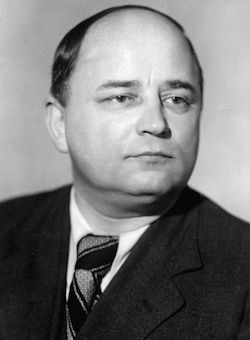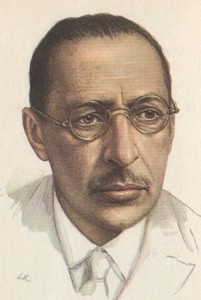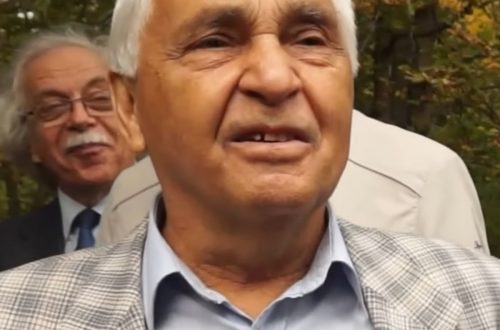
Vissarion Yakovlevich Shebalin |
Vissarion Shebalin
Each person should be an architect, and the Motherland should be his temple. V. Shebalin
In V. Shebalin the Artist, the Master, the Citizen are inextricably linked. The integrity of his nature and the attractiveness of his creative appearance, modesty, responsiveness, uncompromisingness are noted by everyone who knew Shebalin and ever communicated with him. “He was an amazingly wonderful person. His kindness, honesty, exceptional adherence to principles have always delighted me,” D. Shostakovich wrote. Shebalin had a keen sense of modernity. He entered the world of art with the desire to create works in tune with the time in which he lived and witnessed the events of which he was. The themes of his writings stand out for their relevance, significance and seriousness. But their greatness does not disappear behind their deep inner fullness and that ethical power of expressiveness, which cannot be conveyed by external, illustrative effects. It requires a pure heart and a generous soul.
Shebalin was born into a family of intellectuals. In 1921, he entered the Omsk Musical College in the class of M. Nevitov (a student of R. Gliere), from whom, having replayed a huge number of works by various authors, he first became acquainted with the works of N. Myaskovsky. They impressed the young man so much that he firmly decided for himself: in the future, continue to study only with Myaskovsky. This desire was fulfilled in 1923, when, after graduating from college ahead of schedule, Shebalin arrived in Moscow and was admitted to the Moscow Conservatory. By this time, the young composer’s creative baggage included several orchestral compositions, a number of piano pieces, romances to poems by R. Demel, A. Akhmatova, Sappho, the beginning of the First Quartet, etc. As a 2nd year student at the conservatory, he wrote his First Symphony (1925) . And although it undoubtedly still reflected the influence of Myaskovsky, whom, as Shebalin later recalls, he literally “looked into his mouth” and treated him as a “being of a higher order”, nevertheless, the bright creative individuality of the author, and his desire for independent thinking. The symphony was warmly received in Leningrad in November 1926 and received the most positive response from the press. A few months later, B. Asafiev wrote in the journal “Music and Revolution”: “… Shebalin is undoubtedly a strong and strong-willed talent … This is a young oak tree firmly clinging its roots to the soil. He will turn around, stretch out and sing a powerful and joyful anthem of life.
These words turned out to be prophetic. Shebalin is really gaining strength from year to year, his professionalism and skill are growing. After graduating from the conservatory (1928), he became one of its first graduate students, and was also invited to teach. Since 1935 he has been a professor at the conservatory, and since 1942 he has been its director. Works written in various genres appear one after another: the dramatic symphony “Lenin” (for a reader, soloists, choir and orchestra), which is the first large-scale work written to the verses of V. Mayakovsky, 5 symphonies, numerous chamber instrumental ensembles, in including 9 quartets, 2 operas (“The Taming of the Shrew” and “The Sun over the Steppe”), 2 ballets (“The Lark”, “Memories of Days Past”), the operetta “The Bridegroom from the Embassy”, 2 cantatas, 3 orchestral suites, more than 70 choirs, about 80 songs and romances, music for radio shows, films (22), theatrical performances (35).
Such genre versatility, broad coverage are very typical for Shebalin. He repeatedly repeated to his students: “A composer must be able to do everything.” Such words could undoubtedly be said only by someone who was fluent in all the secrets of composing art and could serve as a worthy example to follow. However, due to his extraordinary shyness and modesty, Vissarion Yakovlevich, while studying with students, almost never referred to his own compositions. Even when he was congratulated on the successful performance of this or that work, he tried to divert the conversation to the side. So, to compliments about the successful production of his opera The Taming of the Shrew, Shebalin, embarrassed and as if justifying himself, replied: “There … is a strong libretto.”
The list of his students (he also taught composition at the Central Music School and at the school at the Moscow Conservatory) is impressive not only in number, but also in composition: T. Khrennikov. A. Spadavekkia, T. Nikolaeva, K. Khachaturyan, A. Pakhmutova, S. Slonimsky, B. Tchaikovsky, S. Gubaidulina, E. Denisov, A. Nikolaev, R. Ledenev, N. Karetnikov, V. Agafonnikov, V. Kuchera (Czechoslovakia), L. Auster, V. Enke (Estonia) and others. All of them are united by love and great respect for the teacher – a man of encyclopedic knowledge and versatile abilities, for whom nothing was truly impossible. He brilliantly knew poetry and literature, composed poetry himself, was well versed in fine arts, spoke Latin, French, German and used his own translations (for example, poems by H. Heine). He communicated and was friendly with many prominent people of his time: with V. Mayakovsky, E. Bagritsky, N. Aseev, M. Svetlov, M. Bulgakov, A. Fadeev, Vs. Meyerhold, O. Knipper-Chekhova, V. Stanitsyn, N. Khmelev, S. Eisenstein, Ya. Protazanov and others.
Shebalin made a great contribution to the development of the traditions of national culture. A detailed, scrupulous study of the works of Russian classics by him allowed him to carry out important work on the restoration, completion and editing of many works by M. Glinka (Symphony on 2 Russian themes, Septet, exercises for voice, etc.), M. Mussorgsky (“Sorochinsky Fair”) , S. Gulak-Artemovsky (II act of the opera “Zaporozhets beyond the Danube”), P. Tchaikovsky, S. Taneyev.
The creative and social work of the composer was marked by high government awards. In 1948, Shebalin received a diploma conferring on him the title of People’s Artist of the Republic, and the same year became a year of severe trials for him. In the February Decree of the Central Committee of the All-Union Communist Party of Bolsheviks “On the opera” Great Friendship “” by V. Muradeli, his work, like the work of his comrades and colleagues – Shostakovich, Prokofiev, Myaskovsky, Khachaturian, was subjected to sharp and unfair criticism. And although 10 years later it was refuted, at that time Shebalin was removed from the leadership of the conservatory and even from pedagogical work. Support came from the Institute of Military Conductors, where Shebalin began teaching and then heading the Department of Music Theory. After 3 years, at the invitation of the new director of the conservatory A. Sveshnikov, he returned to the professorship of the conservatory. However, the undeserved accusation and the inflicted wound affected the state of health: developing hypertension led to a stroke and paralysis of the right hand … But he learned to write with his left hand. The composer completes the previously begun opera The Taming of the Shrew – one of his best creations – and creates a number of other wonderful works. These are sonatas for violin, viola, cello and piano, the Eighth and Ninth Quartets, as well as the magnificent Fifth Symphony, the music of which is truly a “powerful and joyful anthem of life” and is distinguished not only by its special radiance, light, creative, life-affirming beginning, but also by the amazing ease of expression, that simplicity and naturalness that are inherent only in the highest examples of artistic creation.
N. Simakova





